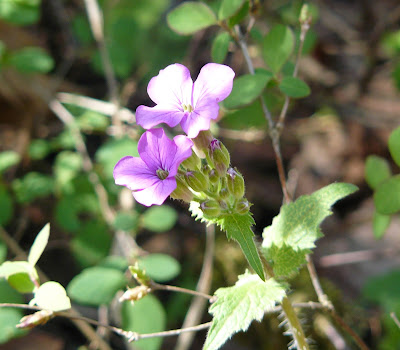My own version of March Madness occurred on 3/31/13 while searching for more flowers on the
Flower Frenzy list. Near Shepperd's Dell (on the Historic Columbia River Highway a few miles East of Crown Point) I found Chocolate Lily (
Fritillaria lanceolata) just about to bloom. 2 points on the list!
 |
| The same plant two days later |
Also at Shepperd's Dell a nonnative species - Honesty (
Lunaria annua) common along roadsides in the Western Gorge. Shepperd's Dell was donated to the City of Portland in 1915 by George Shepperd, a dairy farmer, and has a two-tiered waterfall in a narrow canyon.
And Sticky Blue-eyed Mary (
Collinsia rattanii)
in the photo below -
- both of these flowers are usually late spring bloomers, out early this year. Shepperd's Dell is sheltered and shady, with many species growing on the rock face. Zacheus Collins was an early American botanist.
Columbia Windflower
(
Anemone deltoidea)
A small perennial blooming earlier than usual.
 |
| The tiny, adorable Mimulus alsinoides - Chickweed Monkeyflower - on the list - 1 point | | |
|
|
 |
| Along the road near Ainsworth - the rare and unexpected Fairy Slipper Orchid - Calypso bulbosa - 3 points on the list! |
Close by were Columbia Kittentails (Synthyris stellata) 3 points on the list! This flower was new to me despite it blooming only a few miles from my house.
Then on to the Twin Tunnels trail at Mosier (exit 69 on I-84). Turn left as you come off the exit and wind up the hill to the Twin Tunnels parking area. Glacier Lily (
Erythronium grandiflorum) 1 point on the list - was blooming in the oak forest near the parking lot - look out - there's lots of Poison Oak here. The corms (bulbs) of these lilies were eaten by some Native American tribes.
Walking West toward the tunnel, at the base of the cliff, Miner's Lettuce (
Claytonia perfoliata)was blooming in a moist area. Leaves are edible - miners and European settlers used it. John Clayton was another early American botanist.
 |
| In open sunny areas, Balsamroot is starting to flower - on the list, 1 point (Balsamorhiza sp.) |
Mr. Thornsby reappears on this blog after a winter vacation. He is overlooking Mosier Creek in a clump of Columbia Desert Parsley.
A sparse forest grows up through an ancient lava flow.
The end of the day at The Thirsty Woman pub in Mosier - a great place for a microbrew and a meal to celebrate a total of 12 flowers and 21 points from the Flower Frenzy challenge.

































